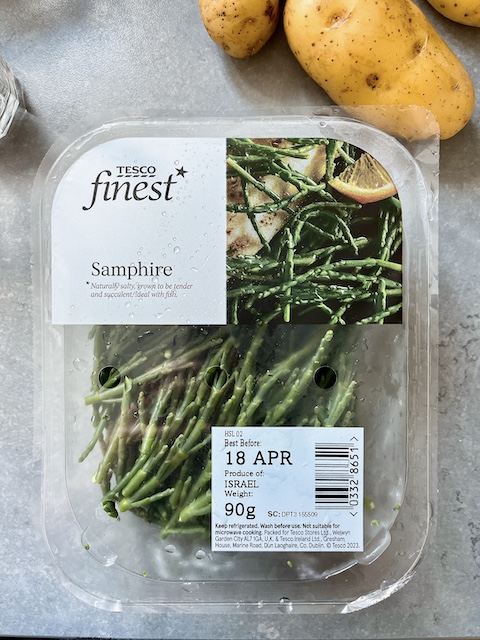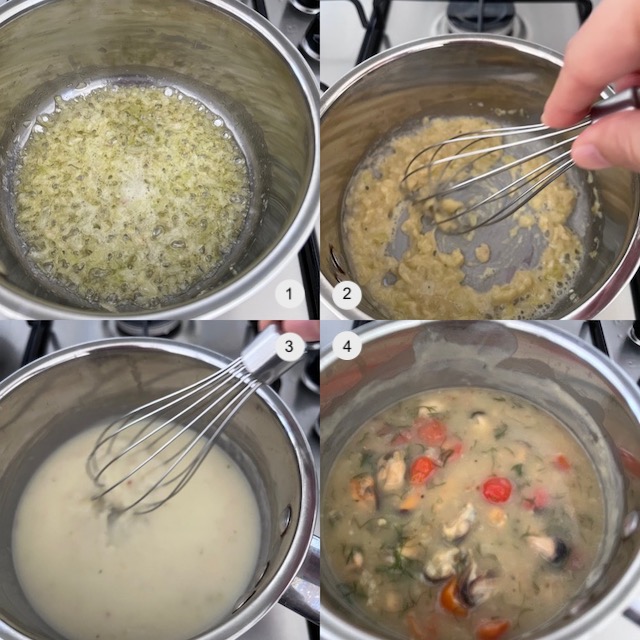I have sampled samphire several times and, now, have finally bought one and tried to cook it in restaurant style. I’m amazed by the samphire’s natural saltiness and putting it together with fish and seafood was a smart move!
It looks complicated, but it’s really not. Every part is simple and straight forward.
It all started from a dish in Ross-On-Wye — a hake fillet sitting on a bed of lovely samphire, purple sprouting broccoli and a velouté made of wild garlic.

The hake itself was outstanding, but what caught more of my attention was the samphire.
Samphire, Nice to meet You!

Out of curiosity, I bought one pack from a supermarket which on it was written ‘naturally salty’. Then I dug in more – samphire is growing on the sea coast where the soil is heavily salted, and it is one of the rare plants to survive in such a salty environment!
Remember, samphire is naturally salty, meaning you don’t have to add any salt to it while cooking. Some say it can be eaten raw, but I rather like it cooked, so I blanched it for about 5 minutes. The longer you blanch, the less salty it is.
Samphire, like seaweed, reminds us of the ocean. That’s why it particularly matches with fish and seafood.
Try the recipe below! It’s pretty straight forward like this:
- Boil potatoes
- Blanch samphire
- Make velouté sauce (A little patience is required)
- Pan sear salmon
- Assemble everything
Here are some cooking tips that I think are useful.
A Few Cooking Tips
- Slowly cook the salmon. Once the skin browned, turn to low heat to slowly cook it. You don’t want an overcooked fish here!
- Check the samphire’s texture. Some are thick, some are thin, hence the blanching time would be different too. Checking is the best practice.
- Sea-salted potatoes. Salt the boiling water generously to ensure the potatoes are well-seasoned.
- Be patient with the velouté sauce. As you stir in the stock, it is once diluted but soon thickens when you keep whisking. It takes some time to reach the consistency that you like. Just be patient!
Salmon with Samphire and Velouté Recipe
This restaurant-style salmon with samphire is easy to replicate at home, can you believe it? It looks complicated, but it’s really not. Get every part right, assemble it like chefs do, et voilà!

Ingredients
Serves 2 as a main
- 2 salmon fillets, in room temperature
- salt and pepper
- olive oil
- 90 g samphire
- 300 g baby potatoes
For the Mussels Velouté
- 15 g butter
- 1 round shallot, finely diced
- 1 tbsp flour (approx. 15 g)
- approx. 200 ml veg stock (or chicken stock)
- salt and pepper
- 1 tbsp lemon juice
- 120 g frozen mussels, thawed
- 50 g ripe cherry tomatoes, halved
- 1 tbsp freshly chopped dill


How to Make
- First, prepare the potatoes. Bring a pot of salted water to a boil and cook the potatoes for 15-20 minutes, until a fork can pierce through. Then drain and set aside.
- Meanwhile, blanch the samphire in UNSALTED boiling water for about 5 minutes. Have a taste to check the texture. Also drain and set aside.
- Then make the velouté sauce. Melt the butter in a small sauce pan over low heat. Tip in the shallots and let cook for a few minutes. Then add the flour and keep whisking until no lumps.
- Stir in the stock liquid gradually and keep on whisking. The sauce will be diluted at once, but gets thickened while you whisk. Keep stirring until it reaches your preferred consistency. Stir in the lemon juice and have a taste. Adjust with salt and pepper.
- Tip in the mussels, tomatoes and dill to cook for a few minutes until the mussels are heated through. Check the taste again and adjust if required.
- Now, move on to the salmon. Season the salmon with salt and pepper. Heat a tbsp of oil in a pan over medium heat. First cook the skin side until crispy, then turn down the heat and cook the other sides until just done. Although a precise time can not be told here, the salmon should just changed colour and start to turn flaky.
- Finally, assembling. Place the samphire and potatoes on a plate, side by side. Dress in the velouté sauce. Then place the beautifully seared salmon on top. Serve with crusty bread for a more filling meal.


